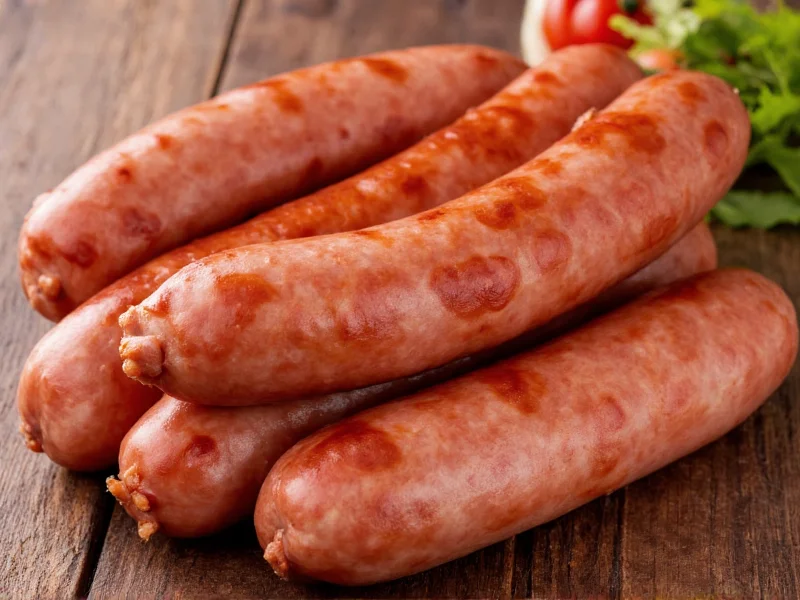The Science Behind Sausage Deliciousness
Understanding what makes the delicious sausage requires examining the scientific principles behind flavor development. The Maillard reaction—the chemical process that occurs when proteins and sugars heat—creates hundreds of flavor compounds during cooking. High-quality sausages leverage this reaction through proper fat distribution and cooking temperatures between 150-160°F (65-71°C).
Fat content proves crucial to delicious sausage preparation. Too little fat results in dry, crumbly texture, while excessive fat creates greasiness. The ideal ratio maintains 70% lean meat to 30% fat, allowing flavors to distribute evenly while providing that satisfying mouthfeel sausage enthusiasts crave.
Historical Evolution of Popular Sausage Varieties
Sausage making dates back to ancient Mesopotamia around 3100 BCE, with early recipes designed to preserve meat. The Romans refined techniques, creating isicia omentata—a precursor to modern burgers. Germanic tribes developed smoked sausages for winter preservation, while Mediterranean cultures favored fresh herb-infused varieties.
Industrialization transformed traditional sausage preparation methods in the 19th century. Casings evolved from natural intestines to collagen and cellulose options, while refrigeration enabled year-round production. Despite technological advances, artisanal producers still follow time-honored techniques that contribute significantly to flavor development.
Global Sausage Varieties Worth Trying
Regional specialties showcase how local ingredients and cultural preferences shape the most delicious sausage varieties. From spicy chorizo in Spain to delicate veal bratwurst in Germany, each culture has perfected unique flavor profiles.
| Region | Sausage Type | Key Flavor Components | Distinctive Preparation |
|---|---|---|---|
| Germany | Bratwurst | Marjoram, nutmeg, white pepper | Grilled or pan-fried with beer |
| France | Andouille de Guéméné | Pepper, wine, smoked pork | Double-smoked over beechwood |
| Mexico | Longaniza | Garlic, vinegar, achiote | Dried and cured with citrus |
| Thailand | Sai Krok Isan | Lemongrass, kaffir lime, sticky rice | Fermented with natural bacteria |
Essential Ingredients for Flavor Development
The magic of what makes a sausage delicious begins with ingredient selection. High-quality meat forms the foundation, but the seasoning blend creates the distinctive character. Salt serves multiple purposes—it enhances flavor, helps extract proteins for better binding, and inhibits bacterial growth.
Professional sausage makers emphasize the importance of freshly ground spices. Pre-ground spices lose volatile compounds that contribute to complex flavor profiles. For example, freshly cracked black pepper contains over 40 aromatic compounds compared to 15 in pre-ground versions. Similarly, garlic and onion powders provide consistent flavor without the textural issues of fresh alliums.
The Critical Role of Casings
Casings significantly impact both texture and flavor release in delicious sausage preparation. Natural casings made from animal intestines allow moisture exchange during cooking, creating a superior texture compared to synthetic alternatives. They also contribute subtle flavor notes that enhance the overall eating experience.
When selecting casings for homemade sausages, consider these factors:
- Natural hog casings provide the traditional snap and flavor release
- Sheep casings work best for smaller sausages like breakfast links
- Collagen casings offer consistency but lack the textural qualities of natural options
- Cellulose casings serve well for smoked products but must be removed before eating
Mastering Cooking Techniques for Perfect Results
Even the finest delicious sausage can be ruined by improper cooking. The ideal method involves a two-stage process: gentle poaching followed by searing. Start by cooking sausages in water or broth at 160°F (71°C) until they reach 150°F (65°C) internally, then finish over medium-high heat to develop the crust.
Avoid common mistakes that compromise flavor:
- Pricking sausages before cooking causes precious juices to escape
- High-heat cooking from the start creates burnt exteriors with raw interiors
- Overcrowding the pan steams rather than sears the sausages
- Skipping the resting period prevents juices from redistributing
How to Select the Best Sausages
When shopping for the most delicious sausage varieties, examine these quality indicators:
- Check ingredient lists for minimal additives—quality sausages contain meat, fat, salt, spices, and sometimes wine or vinegar
- Feel the texture—premium sausages should feel firm but yielding, not mushy or overly stiff
- Examine color—fresh pork sausages should be pink, not gray; smoked varieties should have consistent coloration
- Smell the product—should have pleasant meaty aroma without sour or ammonia notes
Creating Your Own Delicious Sausage at Home
Homemade sausage allows complete control over the best ingredients for delicious sausage. Start with 70% lean meat and 30% fat, preferably from the same animal source. Chill all components thoroughly before grinding—meat and equipment should be near freezing to prevent fat smearing.
The seasoning blend makes or breaks your creation. For a basic delicious pork sausage, combine per 5 pounds of meat:
- 3 tablespoons kosher salt
- 1 tablespoon freshly cracked black pepper
- 2 teaspoons dried sage
- 1 teaspoon red pepper flakes
- 1 teaspoon nutmeg
- 2 cloves minced garlic
- ¼ cup ice-cold water or apple cider
Mix thoroughly using the "slap and fold" method until the mixture becomes sticky and emulsified. This develops the proteins that bind the sausage together. Test a small patty in a skillet before committing to the entire batch—adjust seasoning as needed.











 浙公网安备
33010002000092号
浙公网安备
33010002000092号 浙B2-20120091-4
浙B2-20120091-4